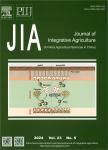The multiple roles of crop structural change in productivity,nutrition and environment in China:A decomposition analysis
作者机构:College of Economics and ManagementChina Agricultural UniversityBejing 100083China Academy of Global Food Economics and PolicyChina Agricultural UniversityBejing 100083China
出 版 物:《Journal of Integrative Agriculture》 (农业科学学报(英文版))
年 卷 期:2024年第23卷第5期
页 面:1763-1773页
核心收录:
学科分类:09[农学] 090101[农学-作物栽培学与耕作学] 0901[农学-作物学]
基 金:This work was supported by the National Natural Science Foundation of China(72061147002 and 72373143) the National Social Science Fund of China(22&ZD085).
主 题:crop structural change land productivity nutrition carbon emissions
摘 要:China s crop structure has undergone significant changes in the last two decades since 2000,with an increase in the share of cereals,vegetables,and fruit,squeezing out other crops.As a result,land productivity,nutrient supply,and carbon emissions have changed.How to reallocate limited farmland among crops to achieve the multiple goals of agrifood systems becomes an important issue.This study explores the sources of land productivity and nutrition supply growth and carbon emissions reduction,and identifies the multiple roles of crop structural change from 2003 to 2020 based on a decomposition analysis.The results reveal that the growth within crops is still the primary driver in land productivity and nutrition supply and the reduction in carbon emissions.However,structural change also plays various roles at different periods.From 2003 to 2010,crop structural change increased the total calorie supply but lowered land productivity and contributed at least 70%of the total growth of carbon emissions.The crop structure was relatively stable,and their effects were modest from 2010 to 2015.From 2015 to 2020,the crop structural change began to play a greater role and generate synergistic effects in improving land productivity,micronutrient supply,and reducing carbon emissions,contributing to approximately a quarter of the growth of land productivity and 30%of total carbon emissions reduction.These results suggest that strategies for crop structural change should comprehensively consider its multiple impacts,aiming to achieve co-benefits while minimizing trade-offs.



